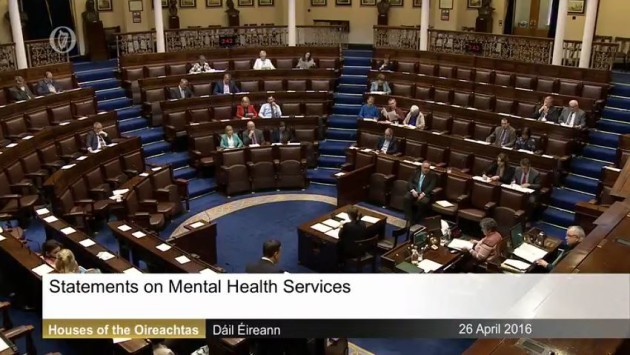Central Bank of Ireland says it will not lower its mortgage rates
PROF PHILIP LANE SAYS ANY LEGISLATION TO CURTAIL RATES COULD DETER POTENTIAL MARKET ENTRANTS?


Central Bank governor Philip Lane dismisses notion of statutory limits on mortgage interest rates despite Michael Noonan statement last year that he would introduce legislation to give the Central Bank control of variable mortgage interest rates.
Central Bank governor Philip Lane dismissed the notion of statutory limits on mortgage interest rates as he said a “high evidence threshold” will be set to justify any move to loosen mortgage loan caps.
Asked about high home-loan rates, Prof Lane said any legislation to curtail interest rates could deter potential market entrants and change the nature of the market as banks would focus on “super-safe” customers .
“It’s a very crude instrument which has many downsides, and is really treating the symptom rather than the underlying cause,” he told reporters in Dame Street at the publication of the bank’s 2015 annual report.
A Bank surplus.
The bank reported a €2.24 billion profit or surplus for the year, €1.79 billion of which was transferred as a dividend to the exchequer.
The “overwhelming contributory factor” was income from sovereign bonds held after the 2013 deal to scrap the Anglo Irish Bank promissory note scheme, said Prof Lane.
Much of this money originated with the State via interest payments on retained bonds and capital gains realised on €2 billion in bonds sold to the National Treasury Management Agency.
The bank is selling the bonds at a faster rate than the minimum schedule agreed with the European Central Bank, but Prof Lane would not be drawn on the speed of future disposals, saying that depended on market conditions.
The bank has already indicated that the first review of mortgage caps will be published in November, but Prof Lane said that the general framework of the regime was intended to be permanent.
Mortgage caps?
He was asked whether housing supply constraints could be attributed in part to the mortgage caps.
Prof Lane said multiple, often conflicting forces, were at work in respect of supply and demand. “Anything that boosts housing demand – where the supply response is not forthcoming – is going to not be helpful.”
He called for “discipline” in addressing remaining vulnerabilities from the crash, saying this embraced fiscal discipline as well as discipline at the level of individual and corporate borrowers. “Yes, we have very good expected growth numbers this year and next year. But there are a lot of downside risks out there.”
Irish Revenue vows to pursue offshore account holders that are avoiding tax payments?
ANNUAL REPORT SAYS REVENUE COLLECTED SOME €60M FROM OFFSHORE INVESTIGATIONS
 V
V 
REVENUE HAS PROMISED TO STEP UP ITS FOCUS ON THE USE OF OFFSHORE LOCATIONS BY THOSE SEEKING TO AVOID TAX FROM IRELAND.
Those who attempt to avoid tax with offshore accounts have been warned by the Revenue Commissioners that greater cross-border co-operation, along with better access to international financial data, will put them under an increasingly harsh spotlight over the next two years.
In its annual report, Revenue has promised to step up its focus on the use of offshore locations by those seeking to avoid tax. It said it had raised more than €60 million from such investigations in 2015.
All told, Revenue collected as much as €45.79 billion for the exchequer in 2015, up 10.6% on the previous year.
The increase was the fifth successive jump in exchequer returns and the second highest figure for net receipts in the history of the State. Only 2007 was higher at €47.5 billion.
Almost all taxes and duties recorded increases, with corporation tax up 49%, capital gains tax up 28% and Vat up 7%.
According to the report, total tax receipts were 7.8% ahead of target as exchequer returns were boosted by a strong trading performance and increased domestic consumption and investment.
Referring to white collar tax evasion, Revenue said the next two years would see developments in the automatic exchange of information with tax authorities abroad, such as the US Internal Revenue Service.
Off shore structures?
Revenue said it would be “carefully considering” how to make the maximum use of information sources to “identify possible cases of tax evasion using offshore structures”.
“If I had an offshore account and I had not declared it, I’d be thinking about it now,” said Revenue chairman Niall Cody. “We are much nicer when you knock on our door than when we knock on yours.”
Revenue conducted more than 460,000 compliance interventions in 2015, yielding more €640 million in tax, interest and penalties, Mr Cody said.
He referred to the success of Revenue’s compliance projects targeted at specific business sectors, including construction and hospital consultants.
Revenue carried out 6,612 audits, which yielded €327.9 million for the exchequer last year, as the overall return from audits and compliance interventions rose by 5.3 per cent to €642.5 million.
Revenue said it collected €63.6 million from 68 cases associated with major legacy investigations last year, including action against holders of offshore accounts.
Mr Cody referred to recent media coverage of the Panama Papers and said Revenue was “examining the implications of the developments in Automatic Exchange of Offshore Financial Information for the Audit Code of Practice.
“While we have had major successes in investigating tax evasion, the new information sources that are coming on stream will shine a light on individuals and businesses that have used offshore facilities.
REAL ACTIVITY?
On corporation tax, Revenue said it would continue to work to ensure that “the profits of multinational corporations are taxed where the real business activity taxes place.”
While attention was placed on the taxes paid in this jurisdiction by multinationals, Mr Cody said the corporation tax base was considerably broader than just large multinationals.
According to the annual report, 97 per cent of property owners paid the local property tax last year. There were 324,000 reminder letters to late payers and mandatory reductions taken from the salaries and pensions of 65,000 people.
Is this for real? Did only 10 TDs really show up in Dail to debate mental health issues?
A FACT CHECK DOES A DOUBLE TAKE ON SOME CLAIMS THAT WENT VIRAL LAST NIGHT.
The Dail heard statements from TDs on the issue of mental health last night, amid increasing anger at the government’s decision to divert part of this year’s budget for mental health to other areas. Throughout the evening, there was a negative reaction to the turnout for the debate, with many tweeting screenshots of an apparently close-to-empty Dáil chamber.
Some placed the number of TDs who showed up at 10, others at 40, while mental health awareness activists and artists the Rubberbandits posted a screenshot on Facebook which featured just seven deputies in the chamber, accompanied by the caption:
Above is a photo of how many politicians turned up to speak about mental health in the Dáil today?
Is that accurate, though?
Béibhinn O’Connor in Dublin emailed us to ask whether it was actually the case that only 10 TDs showed up, so we consulted the official record of the Dáil, and combed through video of the debate to find out the truth.
Remember, if you see a claim you want tested, email factcheck@thejournal.ie.
Claim: Only 10 TDs showed up for a Dáil debate on mental health
Verdict: FALSE by a very wide margin.
66 TDs took part in some way. 33 spoke, 30 were present, and four presided over the debate. One TD presided and listened (Marcella Corcoran-Kennedy), and one TD presided, spoke and listened (Bernard Durkan).
THE FACTS?
A quick note to start. The purpose of this article is just to present the facts. It’s entirely up to you whether the turnout for Tuesday’s debate was acceptable or not.
The debate lasted three hours and 16 minutes, starting at around 3.19 pm, and ending at 6.35 pm.
There were 33 speakers. Here they are, grouped by party with the figures in brackets showing the number who spoke and that party’s total number of TDs:
• Fine Gael (9/50): Leo Varadkar, Helen McEntee, Peter Fitzpatrick, Tom Neville, Pat Deering, Peter Burke, Mary Mitchell-O’Connor, Bernard Durkan, Andrew Doyle
• Fianna Fáil (5/43): Billy Kelleher, Lisa Chambers, Micheál Martin, Robert Troy, Jack Chambers
• Sinn Féin (6/23): Caoimhghín Ó’Caoláin, Louise O’Reilly, Pat Buckley, Brian Stanley, Carol Nolan, Maurice Quinlivan
• Independents (5/19): Thomas Pringle, Seamus Healy, Danny Healy-Rae, Mattie McGrath, Michael Healy-Rae
• Independents 4 Change (1/4): Tommy Broughan
• AAA/PBP (3/6): Gino Kenny, Mick Barry, Richard Boyd-Barrett
• Social Democrats (2/3): Róisín Shortall, Catherine Murphy
• Green Party (1/2): Catherine Martin
• Labour (1/7): Brendan Ryan
Four TDs acted as chairperson over the course of the debate. They were:
• Ceann Comhairle Seán Ó’Fearghaíl (FF), Alan Farrell (FG), Marcella Corcoran-Kennedy (FG), Bernard Durkan (FG)
In addition to the speakers, 30 TDs were present for at least some portion of the debate, based on our close analysis of the videos.
It is possible, of course, that other deputies may have entered and exited quickly enough that their presence wasn’t caught by cameras in the chamber. In which case, we will expand this list.
THE TDS WHO ATTENDED, BUT DIDN’T SPEAK, WERE (GROUPED BY PARTY AS ABOVE):
• Fine Gael (7/50): Hildegarde Naughton, Maria Bailey, Simon Harris, Kate O’Connell, Noel Rock, Richard Bruton, John Paul Phelan
• Fianna Fáil (9/43): Anne Rabbitte, Fiona O’Loughlin, John Lahart, John McGuinness, Frank O’Rourke, Aindrias Moynihan, Declan Breathnach, Eugene Murphy, Pat Casey
• Sinn Féin (6/23): Imelda Munster, Peadar Tóibín, Donnchadh Ó’Laoighaire, Kathleen Funchion, Denise Mitchell, Jonathan O’Brien
• Independents (4/19): Catherine Connolly, Katherine Zappone, Noel Grealish, Dr Michael Harty
• Independents 4 Change (2/4): Mick Wallace, Joan Collins
• Green Party (1/2): Eamon Ryan
• AAA/PBP (1/6): Bríd Smith
• Marcella Corcoran-Kennedy and Bernard Durkan were also at their seats for speeches, as well as presiding over parts of the debate from the chair.
So between speaking, presiding and listening to speeches, this is the breakdown of each party and grouping’s participation in the debate on mental health.
• Fine Gael: 18 out of 50 TDs (36%)
• Fianna Fáil: 15 out of 44 TDs (34%)
• Sinn Féin: 12 out of 23 TDs (52.2%)
• Independents: 9 out of 19 TDs (47.4%)
• Independents 4 Change: 3 out of 4 TDs (75%)
• AAA/PBP: 4 out of 6 TDs (66.7%)
• Social Democrats: 2 out of 3 TDs (66.7%)
• Green Party: 2 out of 2 TDs (100%)
• Labour: 1 out of 7 TDs (14.3%)
That’s 66 out of 158 TDs (41.7%)
A CONCLUSION?
It is quite rare for a large number of TDs to remain in the Dáil chamber over the full duration of a long debate without a vote, such as last night’s.
Typically, deputies drift in and out, delivering their remarks, supporting colleagues and opposing those on the other side of the house, and then leaving again.
The actual number of TDs in the house ebbs and flows over the course of a long debate.
This screenshot, taken during Minister Varadkar’s opening speech on mental health last night, shows at least 29 TDs in the chamber:
This one, taken at a similar stage of a similar debate – Minister Alan Kelly’s opening speech during “Statements on Housing” two weeks ago, shows only 12.
This is not to endorse standard Dáil practices, or make any claim about the relative importance of two different issues.
It is simply to point out that the distribution of attendance seen last night is far from unprecedented in Dáil Éireann.
For better or for worse, debates culminating in a vote, and formal set pieces such as leaders’ questions are often more densely packed than “statements” on a particular issue, however important.
Whatever your view on the importance of mental health, and the appropriate level of attendance and participation in last night’s debate, the facts are clear.
The claim that only seven, or 10, or even only 40 TDs showed up to debate mental health last night, is FALSE.
Some 40% of women ‘don’t feel fit enough’ to go to the gym



MOST OF US WILL HAVE PUT OFF GOING TO THE GYM AT SOME POINT IN OUR LIVES (LET’S BE HONEST, PROBABLY ON MORE THAN ONE OCCASION).
But a poll has found two in five British women postpone their gym workout because they do not feel fit enough.
A new survey also found that 33% of women do not want to go to the gym because they feel intimidated by other fitter or more competitive people.
The survey found women feel intimidated and embarrassed at the gym which puts them off going.
A third are embarrassed what people will think of them when they exercise and 27% said they felt put off because they do not know how to use gym machines, according to the British Heart Foundation survey.
The charity polled 2,000 adults from across the UK as part of its new MyMarathon challenge. Over the month of May, people are being encouraged to run 26.2 miles – yep, that’s what London Marathon runners did in a day – while helping to raise money for heart research.
The My Marathon challenge involves running the same distance over a month that these lot ran in a day.
Lucy Wilkinson, senior cardiac nurse at the British Heart Foundation, said: “Keeping active is vital to help improve your heart health, so it is concerning that what’s putting so many women off exercise is a fear of being judged about how they look and their level of fitness, and feeling self-conscious around others when exercising. Women should feel proud to exercise knowing they are helping to keep their hearts strong.
“And now with the MyMarathon challenge you don’t have to be a slave to the gym. You decide the pace and you decide the place, so it’s a great way to get active without feeling intimidated, and help us beat heart disease.”
Scientists may have just learned how to read your mind
THE UNIVERSITY OF CALIFORNIA BERKELEY TEAM MAPS OUT HOW OUR BRAIN RESPONDS TO INDIVIDUAL WORDS



An image (left) showing a view of one person’s right brain hemisphere. The overlaid words, when heard in context, are predicted to evoke strong responses near the corresponding location in the brain. The colour of each word indicates its semantic category.
For example, green words are mostly visual and tactile concepts, while red words are mostly social concepts. White lines show the outlines of known functional brain regions.
Scientists in the US have raised the possibility of reading a person’s mind aftermapping where the brain responds to individual words.
A team at the University of California Berkeley have built a “semantic atlas” that shows how the human brain organises language.
Brain experts have already defined areas that process information about the meanings of words, known as the semantic system.
This work goes far beyond that however, showing in remarkable detail exactly where in the brain the meaning of individual words is processed.
Prof Jack Gallant and colleagues from Berkeley had seven people listen to hours of stories from a radio programme.
During this time, the scientists used functional MRI scanners to “watch” what was happening in their brains and what areas responded to particular words.
This allowed them to make the connections between a given word and its meaning and where in the brain this connection took place.
They published their findings on Wednesday in the journal Nature.
Brain triggers
Words often have more than one meaning and the map shows this in beautiful detail. The word “top” triggers several parts of the brain, one associated with clothing, another with shapes and measurements and a third with buildings.
In the same way they found that associated words can group together into a single region depending on meaning.
One area dealt with the meaning of words such as wife, mother, pregnant and family, the researchers said. An adjacent area also responded to wife and family but also house and owner.
Each person has a unique semantic map but the researchers were surprised at the similarity between subjects in terms of the areas of the brain involved.
The research was not about developing a mind-reading device, yet being able to localise where a word is interpreted may open the way to such a development.
It could help patients who have difficulty communicating express what they want to say without speaking, the researchers said.
The research also serves efforts to understand how the brain organises language. The team produced a video that helps explain how the brain responds to words.



No comments:
Post a Comment